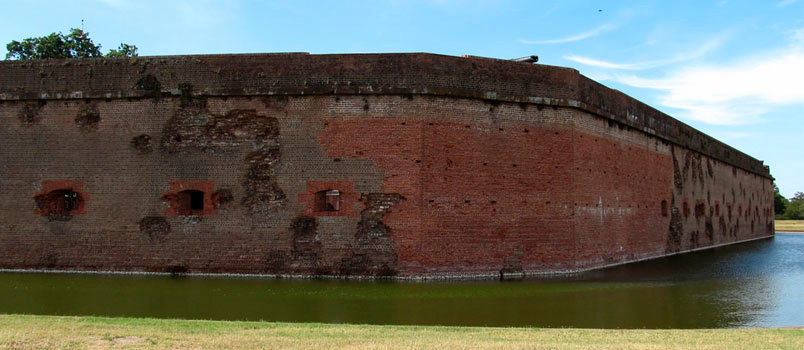 The walls off the coast of Savannah still bear the scars left by Union ships at the beginning of the Civil War. KEN LUND/Flickr
The walls off the coast of Savannah still bear the scars left by Union ships at the beginning of the Civil War. KEN LUND/FlickrIt was said to be impenetrable. If history has taught us anything, it’s that things that are said to be impenetrable are usually going down. Good and hard. This was no exception.
Fort Pulaski is located just off of the Georgia coast. It was built in response to the War of 1812, just in case any other countries had any wild and crazy ideas. As the times changed, the fort would be used as a defense from the Union army.
It’s easy to see why someone would think that Fort Pulaski was indestructible. In a way, it looks more like a castle than a fort. It even has a moat around it, as if the Atlantic Ocean weren’t enough of a barrier.
If you don’t know anything about history and you take a tour of Fort Pulaski, you’d think that they were really starting to let the place go. At one point, when you turn a corner and look at one of the massive walls, you see that it’s covered with holes. Big holes. If you look close enough, there’s still a cannonball lodged in one of those holes. It was put there courtesy of the Union army.
That wasn’t supposed to happen. There was no cannon powerful enough to reach the walls of Fort Pulaski. Or so it was thought. But the Union had developed a rifling system that allowed cannons to travel much further than was previously possible. You can imagine the shock when the men inside Fort Pulaski saw their walls begin to tremble.
There was another problem. As the walls started to give way to the constant pounding of Union fire, the residents of Fort Pulaski noticed something. Once the wall finally fell, the next wall to be hit would be the one where all of their gunpowder was stored. If something didn’t happen soon, Fort Pulaski would be the first manned spacecraft to the moon.
So something happened.
Confederate soldiers surrendered Fort Pulaski to the Union army.
Fort Pulaski fell for two reasons: poor planning inside the walls and a mixture of arrogance and ignorance as to what was going on outside of the walls.
Churches work the same way.
Rather than concerning themselves with training up disciples and taking the gospel outside of their walls, many churches are content to merely hide behind those walls. If they were forced to write out an honest mission statement, it would say something like, “We exist to stay out of debt and keep the doors open.”
No one ever asks what the point is of keeping the doors opened and the budget balanced if disciples aren’t being made. Hint: if disciples aren’t being made, there is no purpose in keeping the doors opened and the budget balanced.
I’ve heard people say that a church is a generation away from closing the doors. I disagree. Every church is one Sunday morning away from collapse. All it takes is one week of abandoning the mission and message of Jesus Christ.
When the church allows sin, consumerism or indifference to knock them off of their mission, rather than raising up members who are eager to make more disciples, they settle for making sure that the stockholders (read: tithers) are all happy. Rather than training students to defend their faith, they entertain those students and keep them busy and then wonder why those students can’t seem to navigate their way through the godlessness on their college campuses.
In the 1960s, Fort Pulaski made the full transition from a military base to a park. By the 80s, it had a museum. Instead of defending the coast of Georgia, it sold t-shirts.
Your church can have the same fate. Rather than being a disciple-making factory, it can very quickly turn into a museum where people walk through and talk about the good old days.
All it takes is a little negligence about what’s going on inside the church’s walls and a little apathy about what’s going on outside those walls.
All it takes is one Sunday.
This post originally appeared at Sanders' blog.